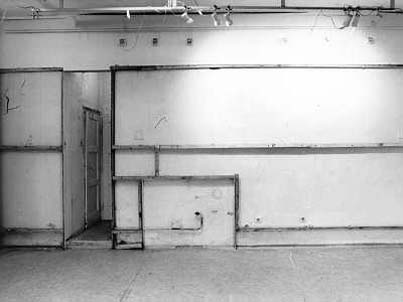|
The original wall of the Liget Gallery was bordered up with chipboard panels, which were attached at the back. The chipboard was present throughout the gallery. The corners of the hall were connected with a skirting board, and chipboard even covered the removed heating units. The standard sized panel defined the size of the chipboard, as well as the size of one of the gallery doors through which it had to come. The panels were connected with nails, and later, the places where they met were selotaped and later corigated with polyfiller. The power points created in the original wall were continued with extensions and new connectors. The painting of the panels was generally performed with white spray paints. The wall opposite the entrance, what could be called the main wall, was composed from five interdependant panels, the panel covering the removed heater, as well as, stiched above it, the section containing the connectors, and picture rails. When the panels were removed, the panels became covered with numbers and written instructions, as well as with fingerprints from those taking them down. In places, the paints were cracked, in others, they were almost unremovable.
On the back of the panels, at the points where they were fixed, the material was cracked and perforated. When the panels were taken down, the elements found their way into their coincidental places. Which at the same time changed continuously, as other people utilised the space. It occured to me that the entire process was like when I make order on my desk.

Rauch - Menesi
Liget Galéria, Budapest, 1995 (with Christoph Rauch)
next
|
